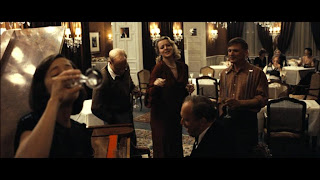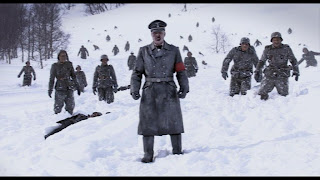Category: documentaries / In category: 9 of 10 / Overall: 85 of 100
 How to tell if people have too much free time on their hands: they make models constructed entirely of matchsticks; they can recite painstakingly memorized screeds of useless information; they write letters of complaint, usually to do with the disgraceful, decadent, wouldn’t-have-happened-in-my-day standards of film, TV and music. They count the expletives in movies.
How to tell if people have too much free time on their hands: they make models constructed entirely of matchsticks; they can recite painstakingly memorized screeds of useless information; they write letters of complaint, usually to do with the disgraceful, decadent, wouldn’t-have-happened-in-my-day standards of film, TV and music. They count the expletives in movies.Seriously: when was the last time you had a pad and pencil on your knee during a Scorsese DVD marathon, keeping score? You’d wear the pencil sharpener out during ‘Casino’!
‘Casino’, according to this page on Wikipedia, has 435 uses of the word fuck or a derivative thereof, leaving its perfume-mouthed-by-comparison precursor ‘Goodfellas’ lagging way behind with 300 and ‘The Boondock Saints’, a film by this reckoning so clean in its dialogue it could be programmed for children’s TV, even further behind with 239. ‘Bad Santa’ ain’t so bad at all with just 173, while ‘The Blair Witch Project’ has 154, most of them apropos of losing the fucking map. ‘In Bruges’ uses fuck a paltry 126 times, but wins out in the cunt stakes. ‘Swingers’ only just scrapes the three figures, proving that being the money don’t mean shit when it comes to saying fuck.
But, dear readers, the fuck-laden swear-fest that is ‘Casino’ is by no means the sweariest film of all time. In fact, it’s number three on the Wikepedia list. Number two is Gary Oldman’s chuckle-free directorial debut ‘Nil By Mouth’ with 470 fucks, but since it’s Ray Winstone who says most of them it’s actually pronounced “faack”, not that I’ve got a problem with that, not at all, this is Ray faackin’ Winstone and he can pronounce fuck any faackin’ way he faackin’ wants. Innit?
Number one with a bullet, though, is Steve Anderson’s documentary ‘Fuck’, a film that uses the word fuck so many times, it’s even in the title. Fuck, it is the title! ‘Fuck’ uses fuck 824 times. That’s a fuckload.
Anderson’s film, while stylistically bland (a succession of talking heads against a black backdrop punctuated by occasional bits of animation), engages in a genial way with its subject. The contributors basically fall into one of two camps: pro-fuck or anti-fuck. The pro-fuck brigade include porn stars Ron Jeremy and Tera Patrick, who talk a lot more sense than the self-appointed moralists in the other camp, gonzo journalist-cum-demented-prophet Hunter S. Thompson, and comedians Bill Maher, Drew Carey, Janeane Garofalo and the Big Yin himself Billy Connolly (without whom no documentary on swearing would be complete). Here’s Connolly on the universality of the expression “fuck off”:
“ ‘Fuck off’. It’s such a lovely pair of words. And it’s international. I don't care where you are - if somebody’s fucking with your bags in Lhasa Airport in Tibet and he’s got a shaven head and saffron clothes on and you say ‘Hey, fuck off’, he knows exactly what you mean. Exactly! He will fuck off. Off he will fuck.”
 The anti-fuck faction includes conservative statesman Alan Keyes (the words “conservative” and “statesman” should tip you off), self-styled “Miss Manners” Judith Martin (a woman who looks like Mrs Bates resurrected and given a bad haircut), and whiter-than-white 50’s poster boy Pat Boone (and when I say whiter-than-white, that’s just his teeth!) who advocates without a trace element of irony that swearing is indicative of sub-literacy and that there’s no reason to tell someone to go fuck themselves when you could just as easily invite them to “impregnate yourself on the way to the door”.
The anti-fuck faction includes conservative statesman Alan Keyes (the words “conservative” and “statesman” should tip you off), self-styled “Miss Manners” Judith Martin (a woman who looks like Mrs Bates resurrected and given a bad haircut), and whiter-than-white 50’s poster boy Pat Boone (and when I say whiter-than-white, that’s just his teeth!) who advocates without a trace element of irony that swearing is indicative of sub-literacy and that there’s no reason to tell someone to go fuck themselves when you could just as easily invite them to “impregnate yourself on the way to the door”. Stop and think about that for a moment. What Boone is essentially saying is that it’s perfectly fine to reach a point where you no longer wish to debate intelligently with someone, where you reach for an insult, a kiss-off or a term of offence, where you make the decision to put together a sentence designed to show your contempt for the other person, to leave them stung and offended … and that it’s okay to do this just as long as you don’t use the word fuck. To my way of thinking, that’s the stuff of hypocrisy and moral cowardice. And besides, if everybody stopped saying “go fuck yourself” and started saying “go impregnate yourself” instead, “impregnate” would eventually take on the force and offensiveness of “fuck”. Why? Because they’re both words. Fuck, screw and shag have the same colloquial meaning. The only difference is that some arbitrator of moral decency decided, seemingly at random, that fuck was deeply and unutterably offensive while the other two were merely slang. They’re all just words, put together with the building blocks of letters. The only power they have is the power we give them.
Neither for nor against, expert witnesses Geoffrey Nunberg and Rheinhold Aman (both linguists) provide important testimony. Aman is the unsung hero of the film, discussing the etymology of vulgarity with academic gusto (on the myth that fuck is an acronym for Fornication Under Command of the King: “that’s 100% bullshit”) and even widening the remit to the non-verbal usage of fuck. Here’s Aman on what it truly means to flip someone the bird:
“This gesture … means ‘I’m going to fuck you in the ass’, which literally means ‘I’m going to make a woman out of you’.”
(Tomorrow, when that asshole in the 4x4 cuts you up as you’re driving to work and you give him the finger, that’s what you’re telling him. Fucking awesome!)
If I wanted to be critical, I could say that Anderson gives the pro-fuck fellas and the neutrals a fairer hearing than the anti-cuss-word camp, but to be honest the moralists make asses of themselves quite effectively enough without Anderson needing to resort to cheap editing tricks. It’s never as one-sided as ‘Religulous’, though, and Anderson is wise enough not to get hung up on a “to swear or not to swear” debate. ‘Fuck’ goes on to consider the word historically, its place in the changing social and political tides of the 70s, its use by protestors, its increasing proliferation in movies and music (did you know that NWA’s ‘Fuck Tha Police’ prompted the FBI to write to the band denouncing their music, the first time the Bureau has publically taken a stance on a creative work?), and the issue of censorship. Particularly in America. Particularly the FCC. This organization has the power to fine broadcasters up to $325,000 per incidence of obscenity. As the film approaches its end credits, Anderson notes that there have been over 800 uses of fuck in ‘Fuck’, meaning that if it were aired on public television and fined per incidence, the total fine would be in the region of $260,000,000. (By way of comparison, there are 48 fucks in this article which means that if it were read out on a public broadcast station in America, they’d be hit with a fine of over fifteen and a half million dollars.)
Anderson really comes out of the pro-fuck closet here, choosing this note to end the film on and Steve Earle’s magnificently rallying ‘F the CC’ (chorus: “fuck the FCC / fuck the FBI / fuck the CIA / living in the motherfucking USA”) as his end-credits ride-out. And it’s hard not to raise a glass at the fact that this 93-minute film achieves a celebration of two so frequently overlooked things: common sense and freedom of speech.
After all, it’s just a word.








 The sheer god-awfulness of British society’s attitudes to homosexuality at that time (and, from the experience of some of my gay friends, it seems to be an inculcated prejudice that’s still a long way from being eradicated) are effectively highlighted. Fry’s performance is exemplary, infusing Wilde with a dignity and a vulnerability beneath the flamboyance and flippant witticisms.
The sheer god-awfulness of British society’s attitudes to homosexuality at that time (and, from the experience of some of my gay friends, it seems to be an inculcated prejudice that’s still a long way from being eradicated) are effectively highlighted. Fry’s performance is exemplary, infusing Wilde with a dignity and a vulnerability beneath the flamboyance and flippant witticisms. 







































